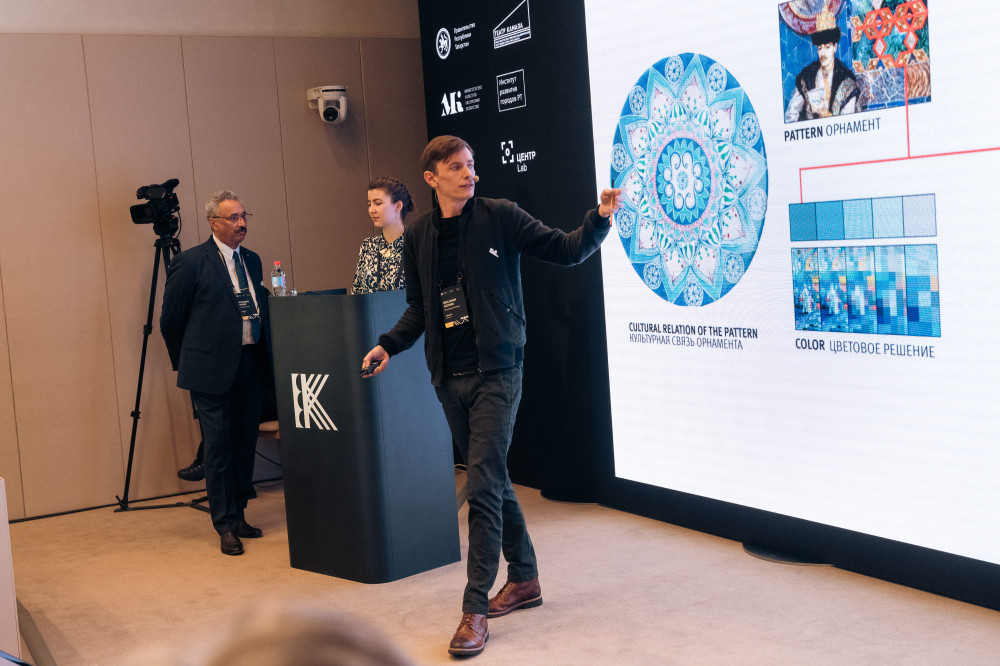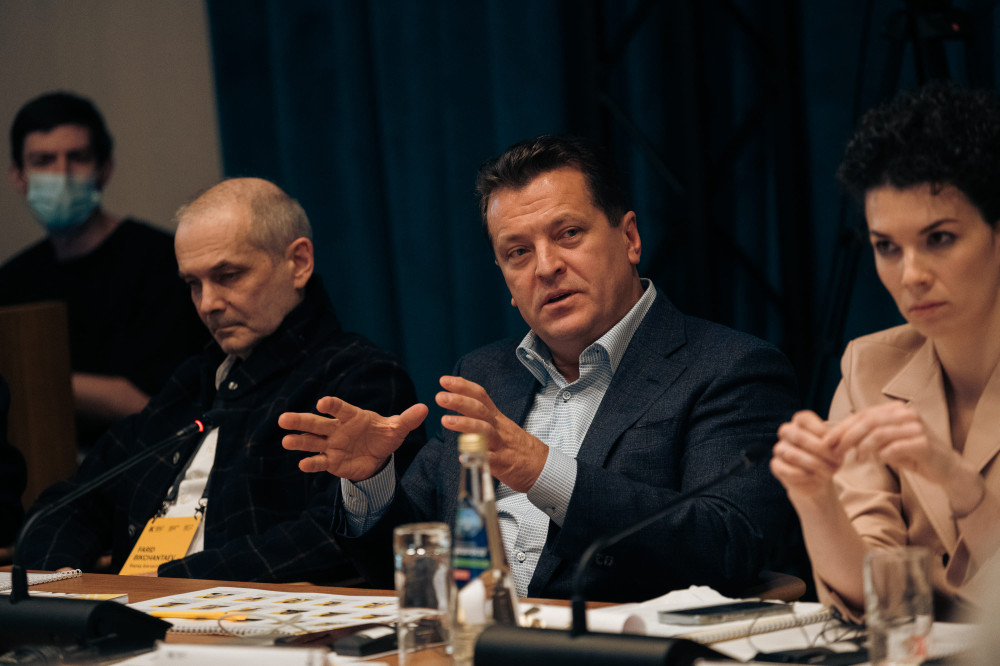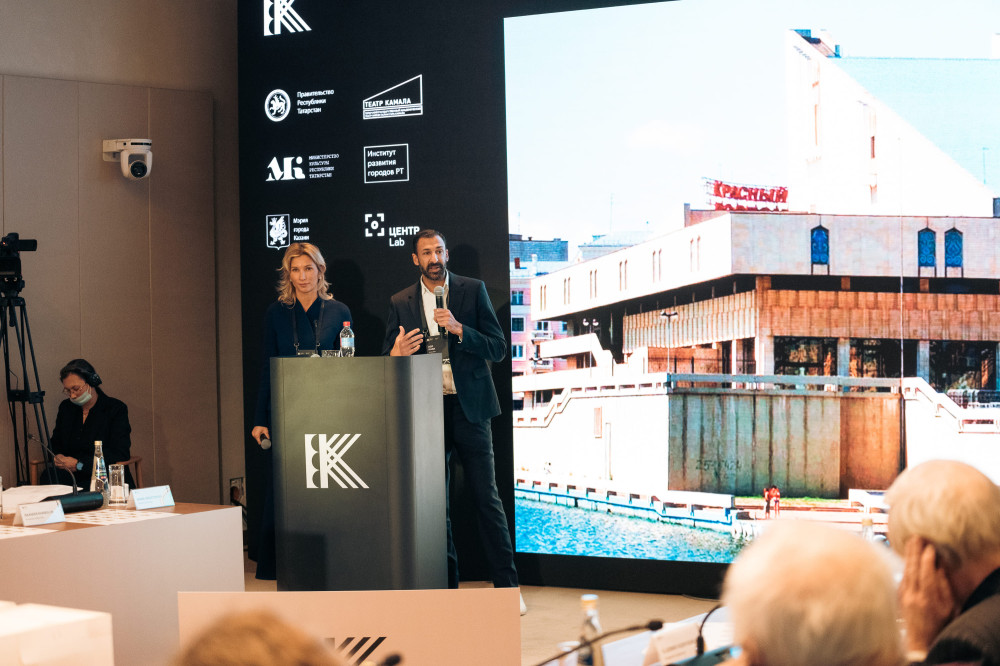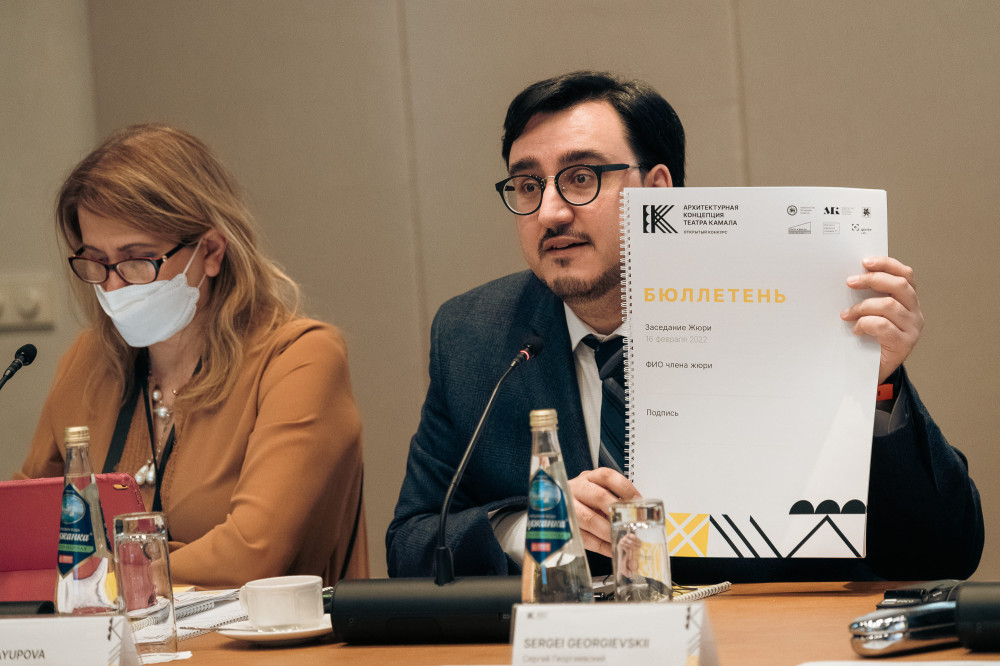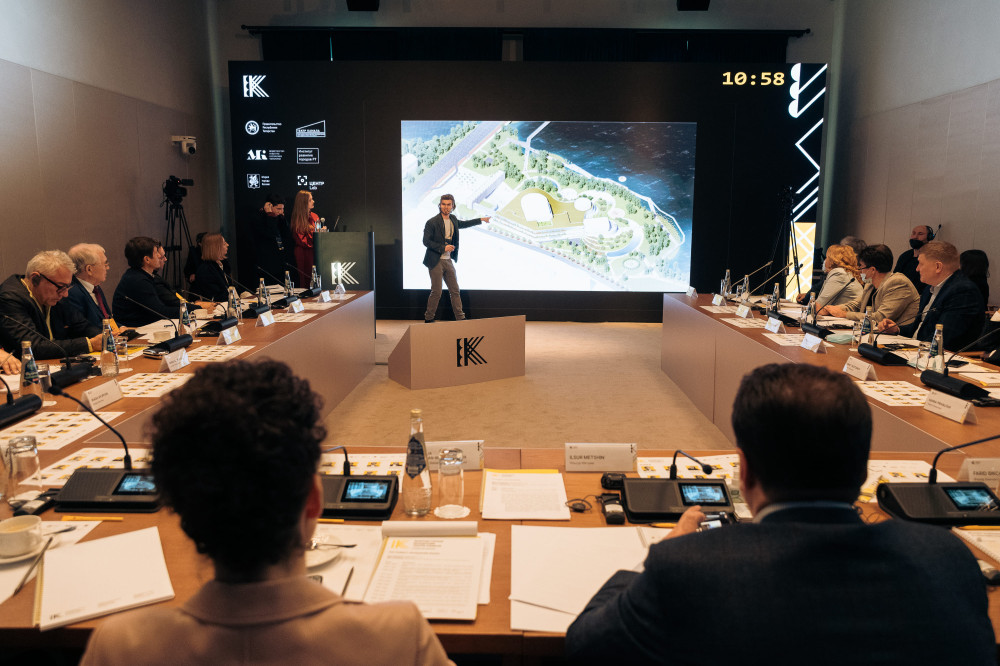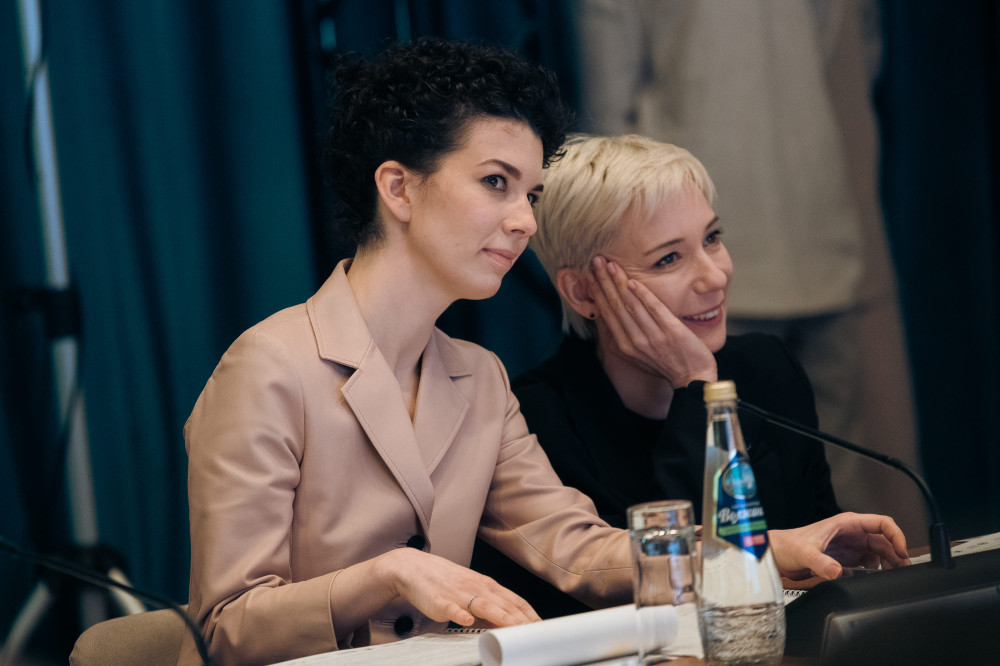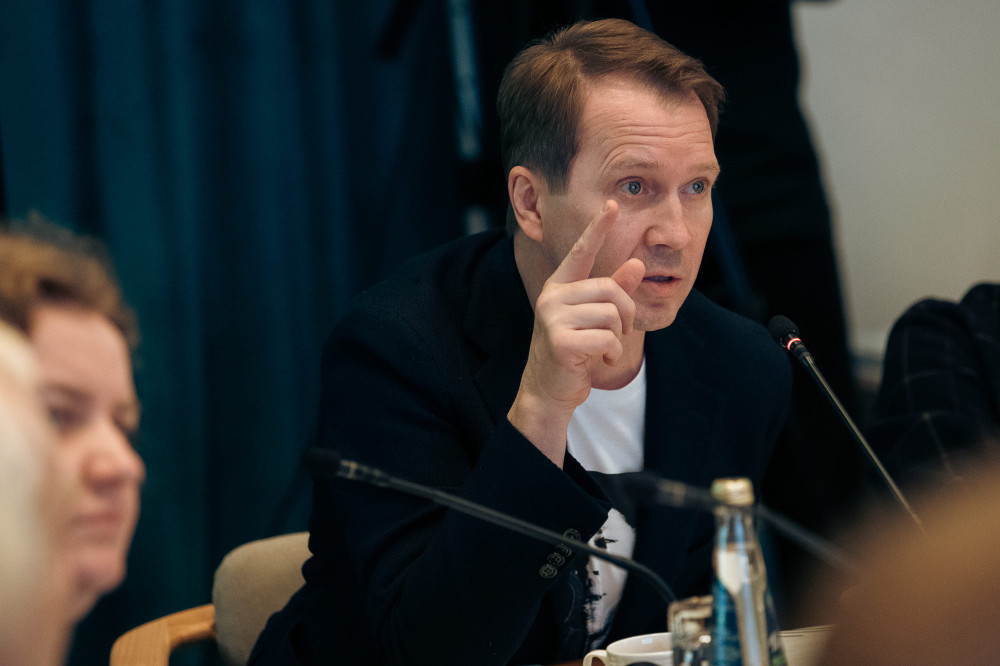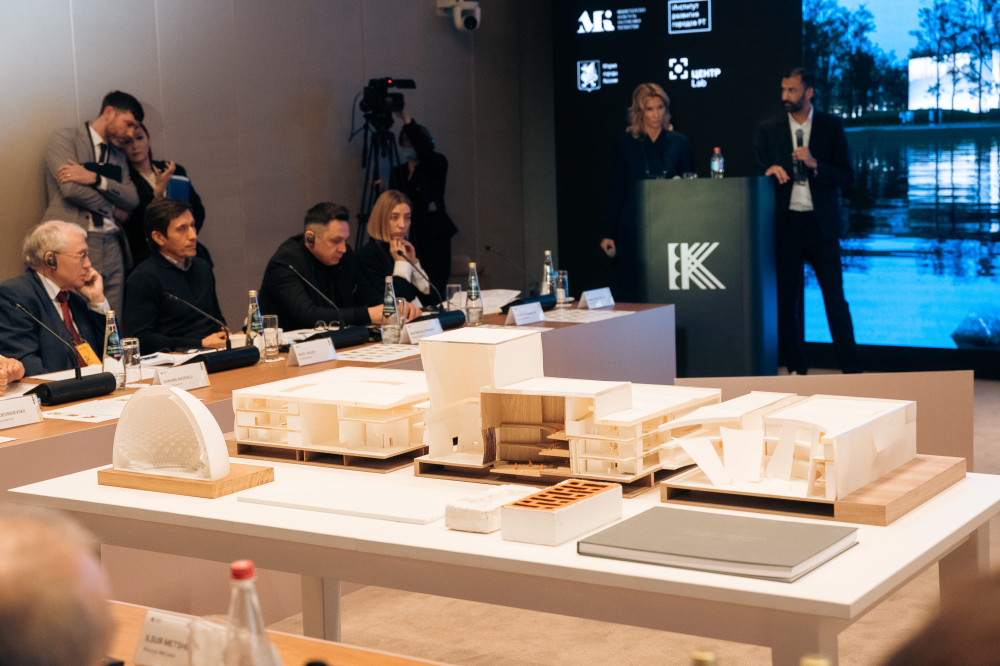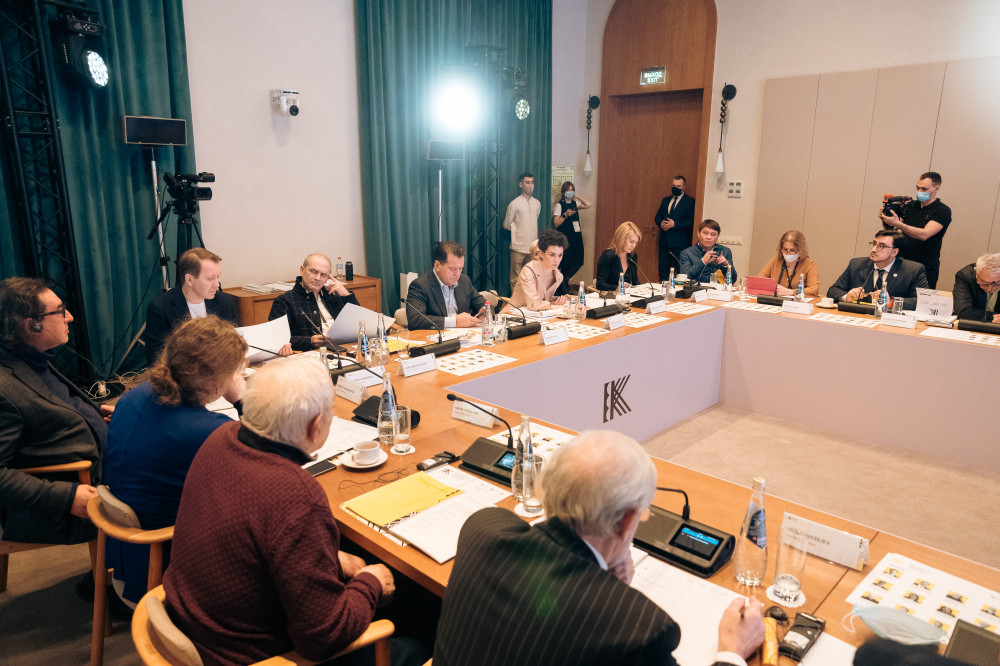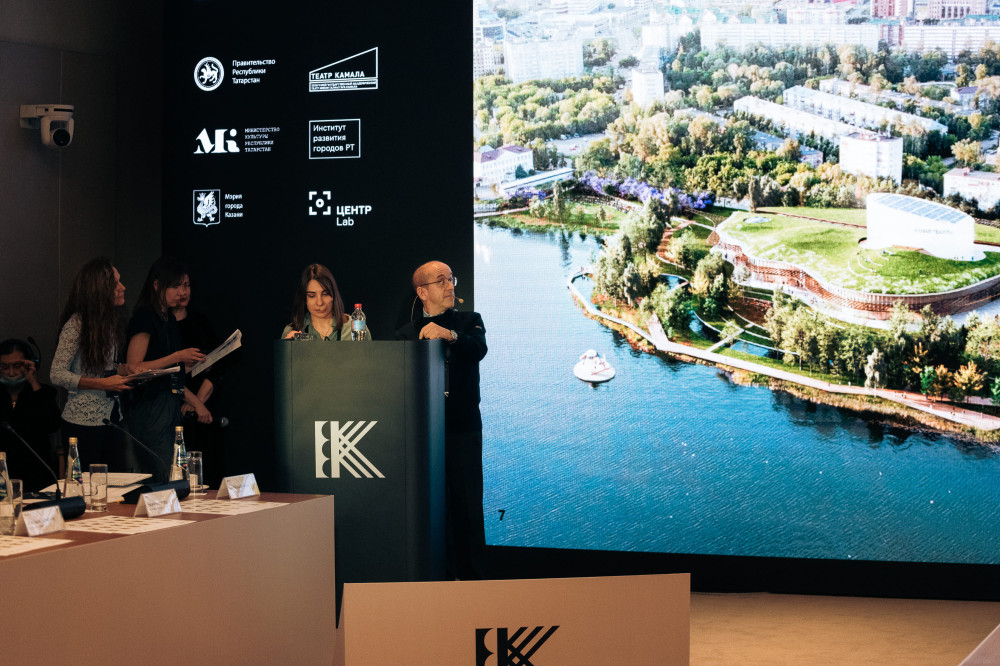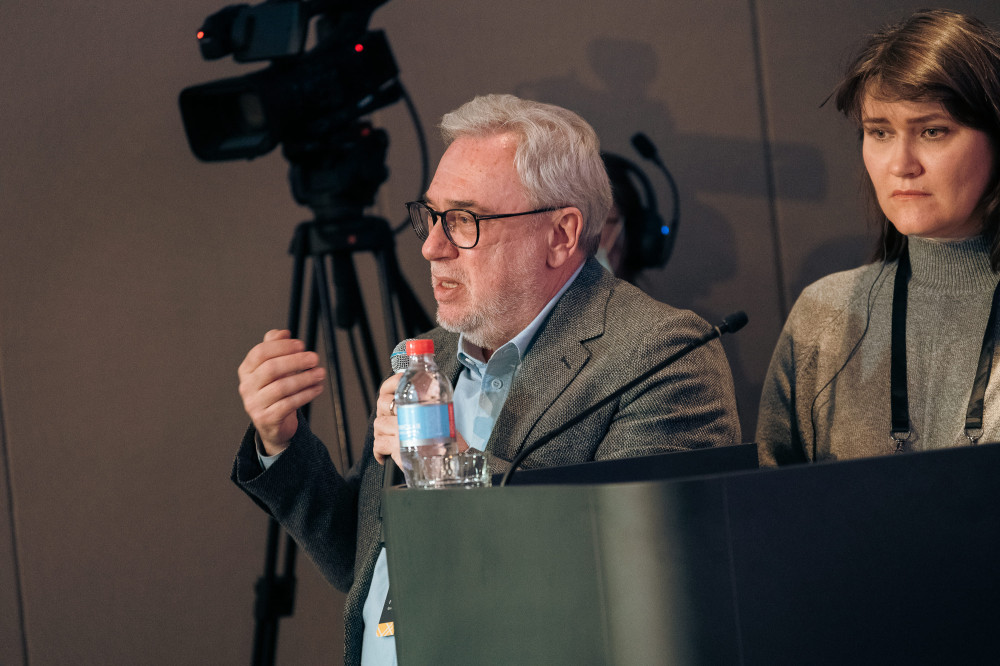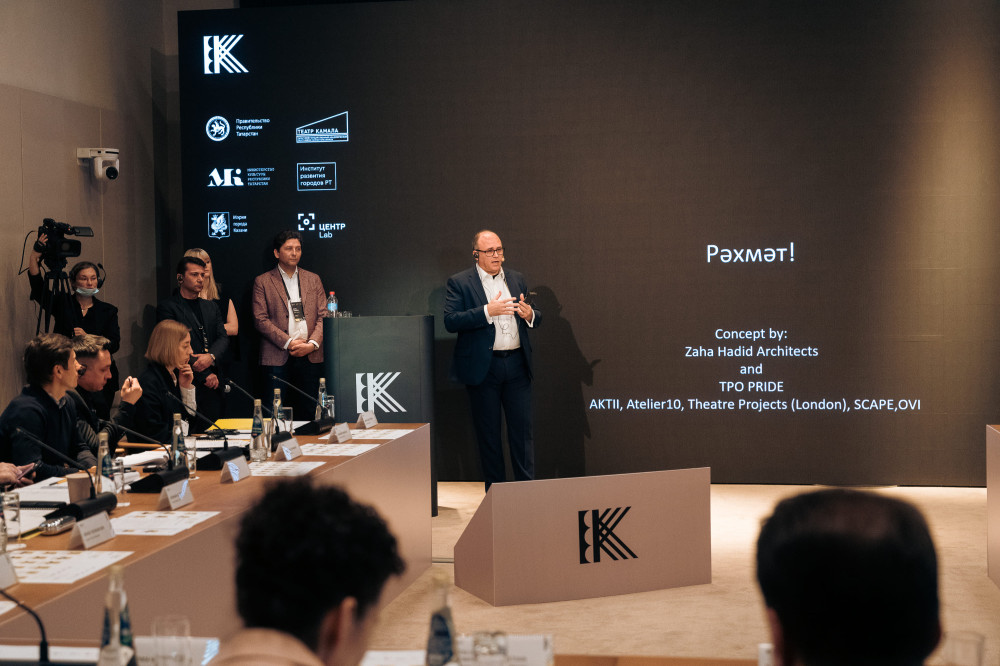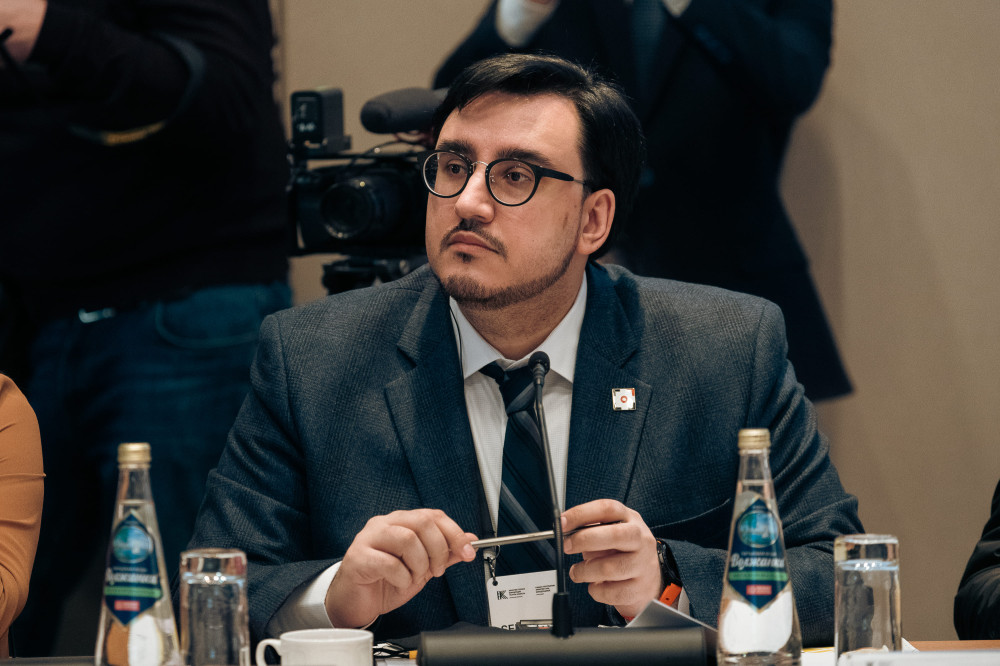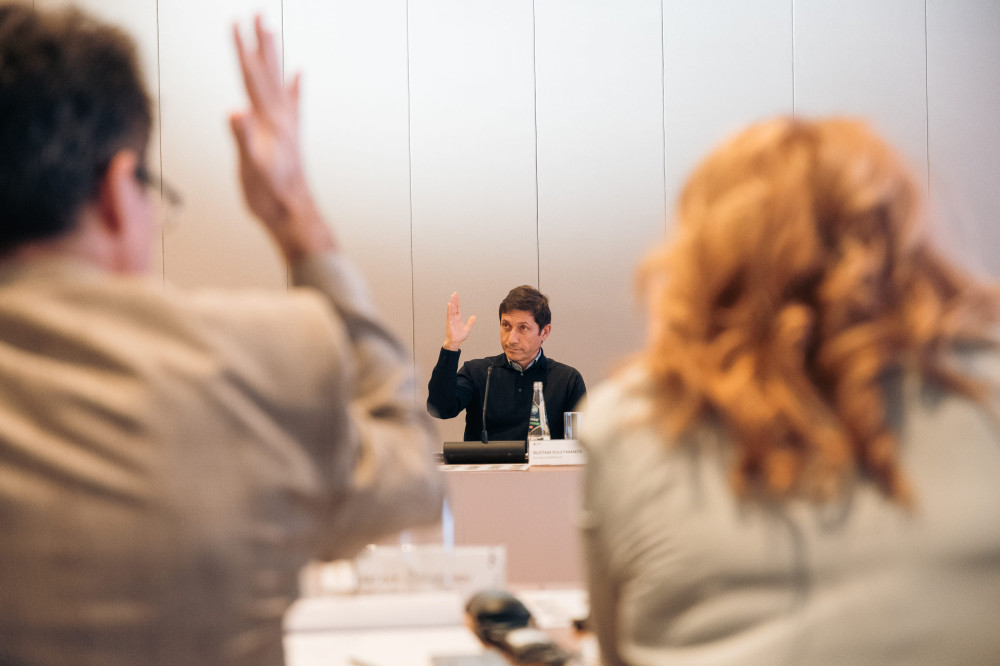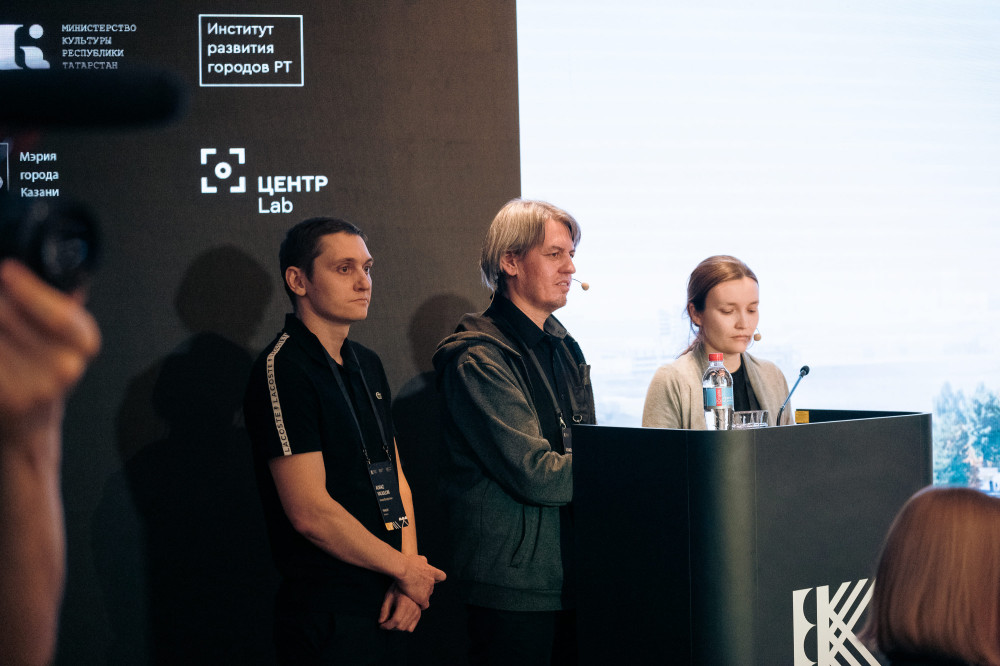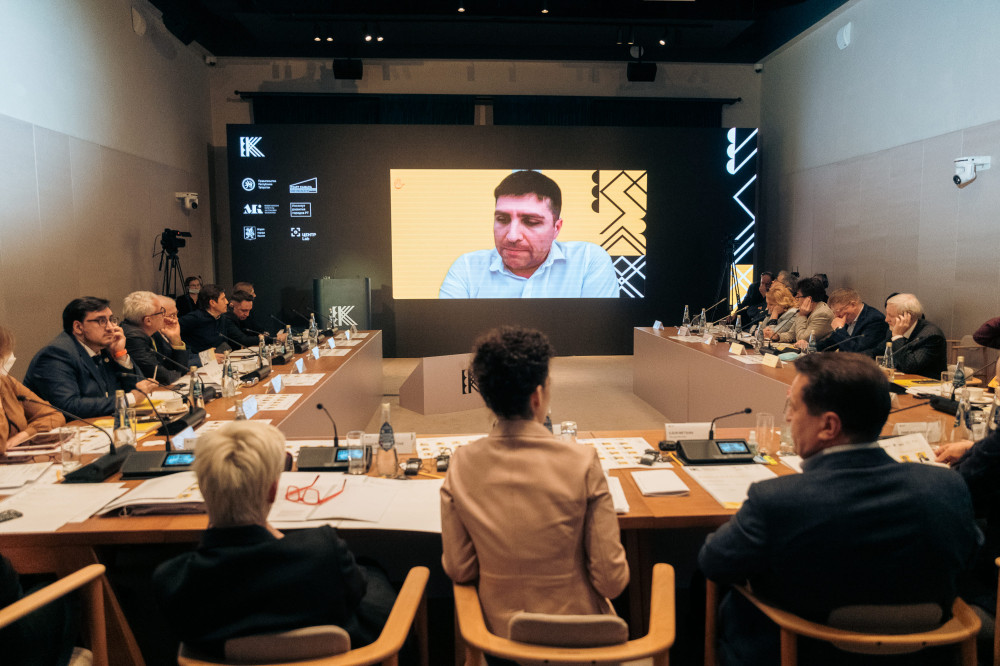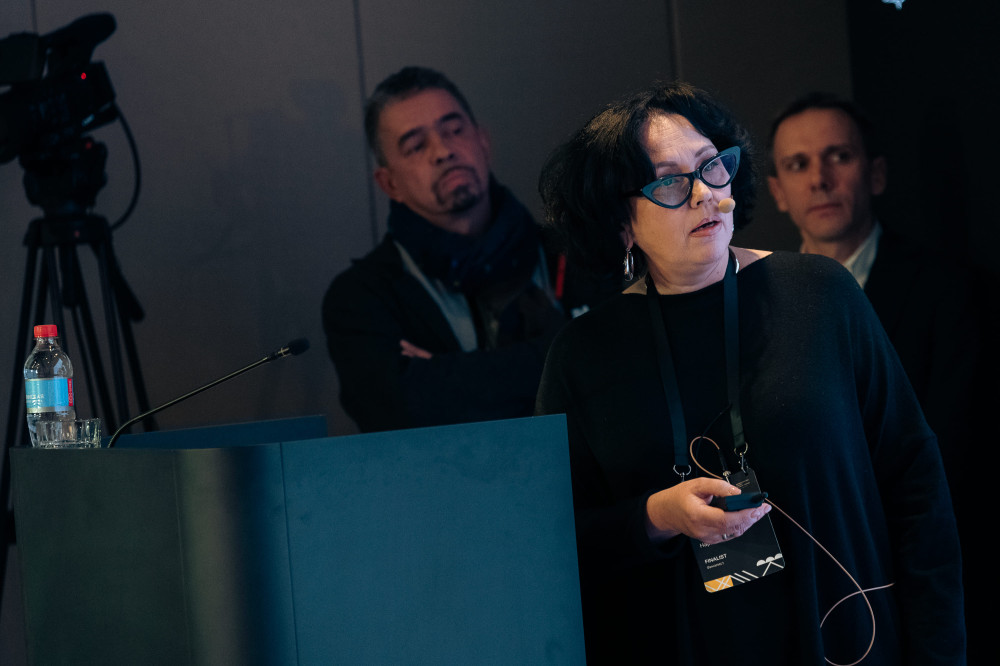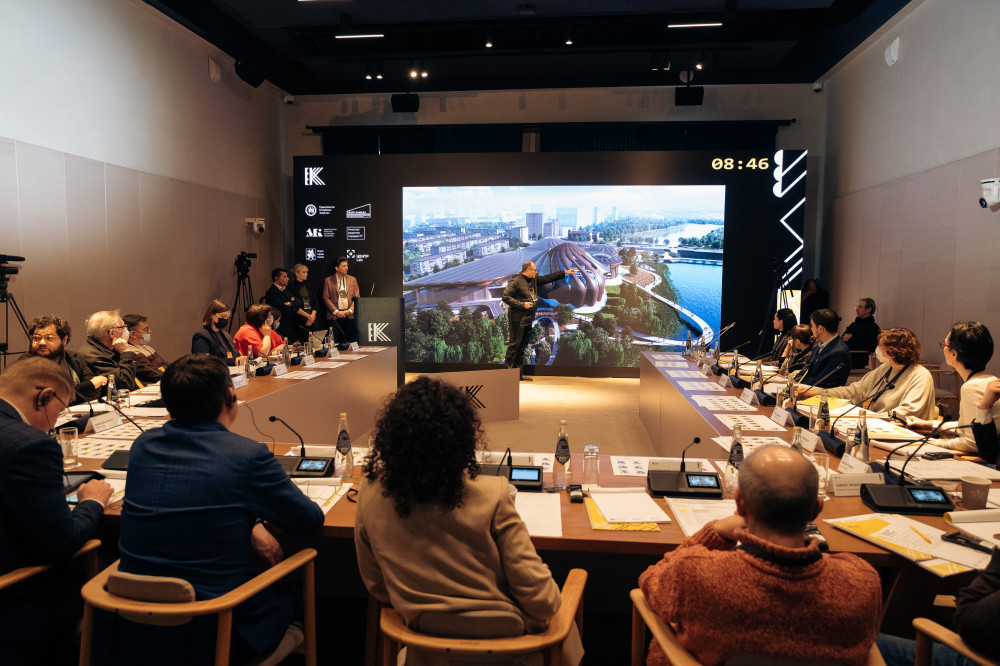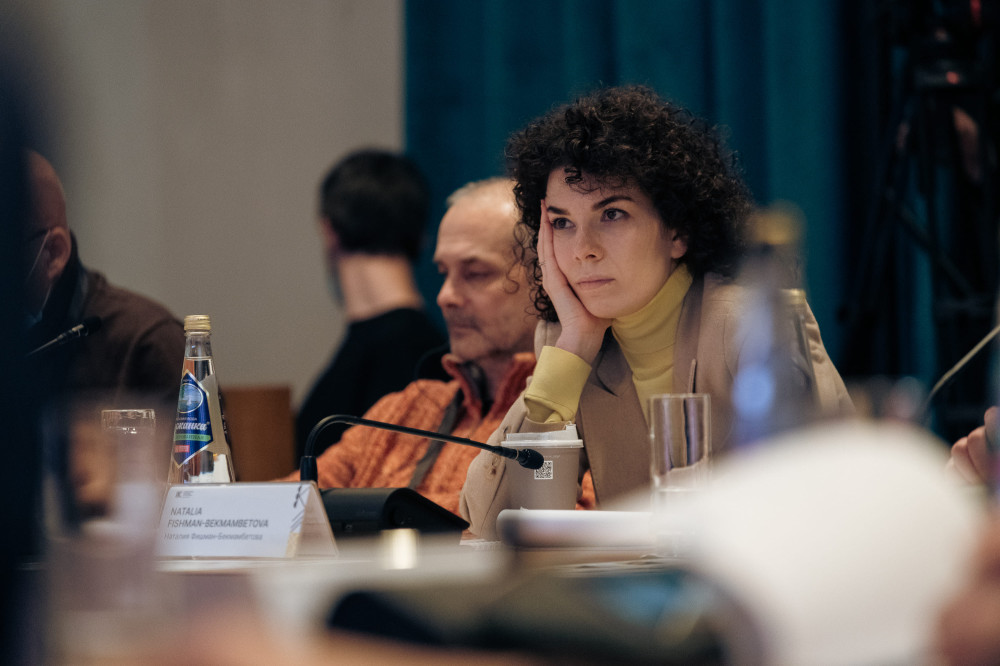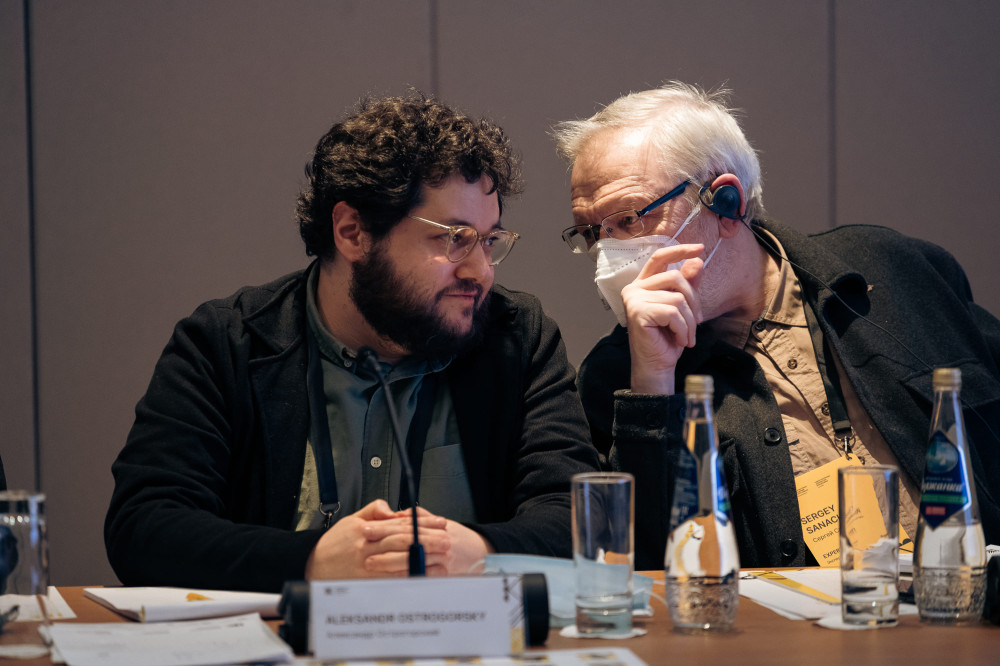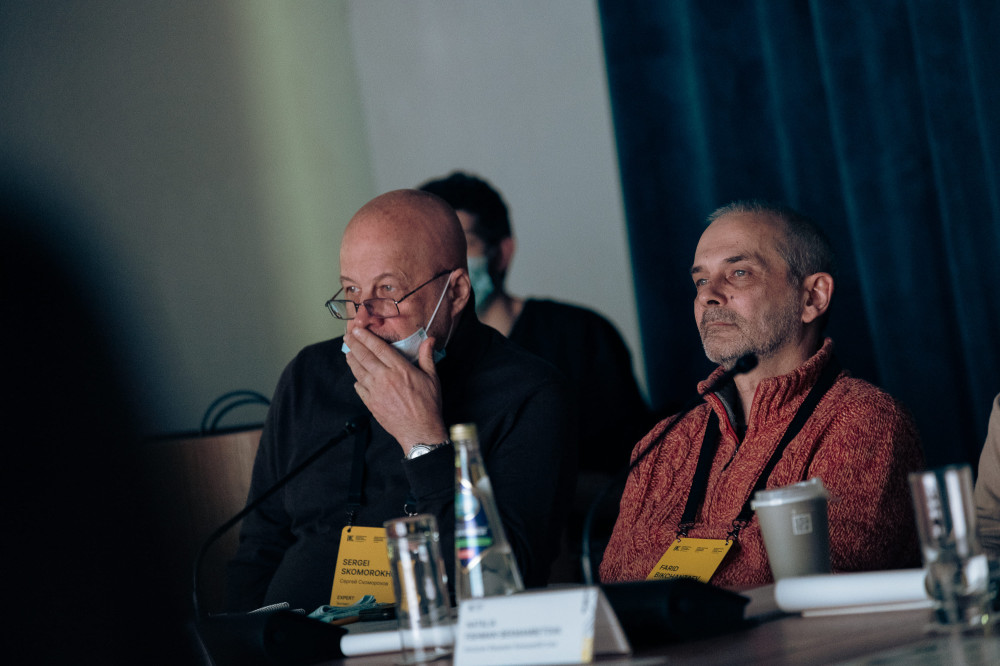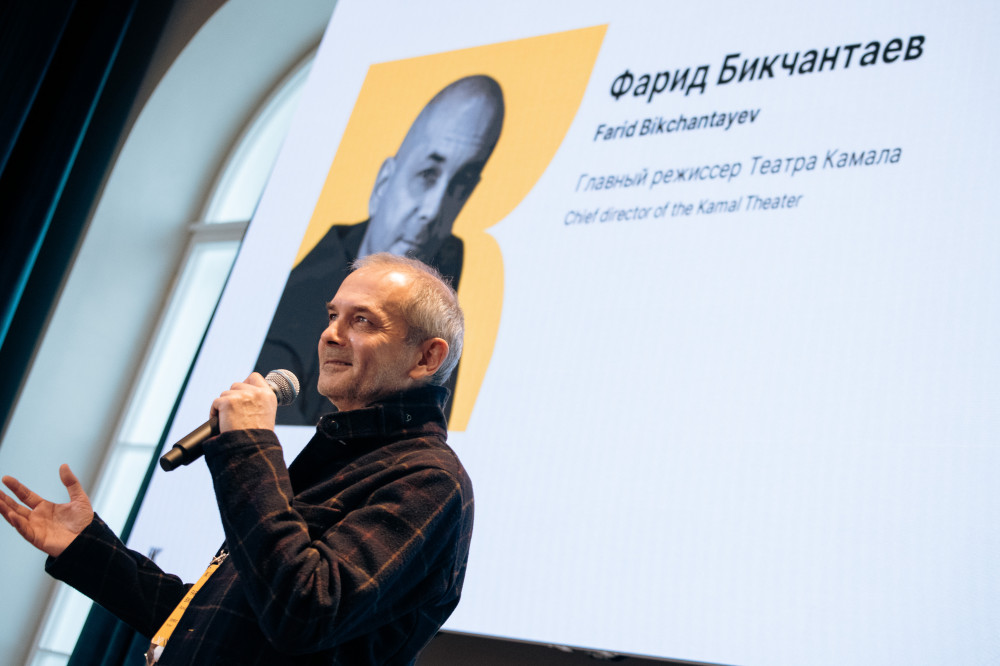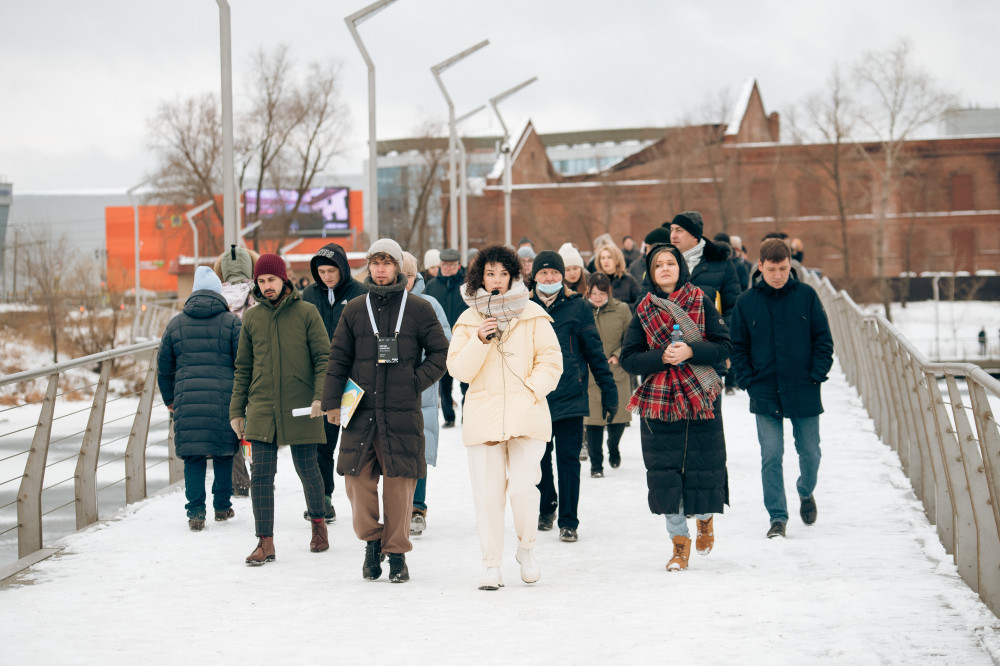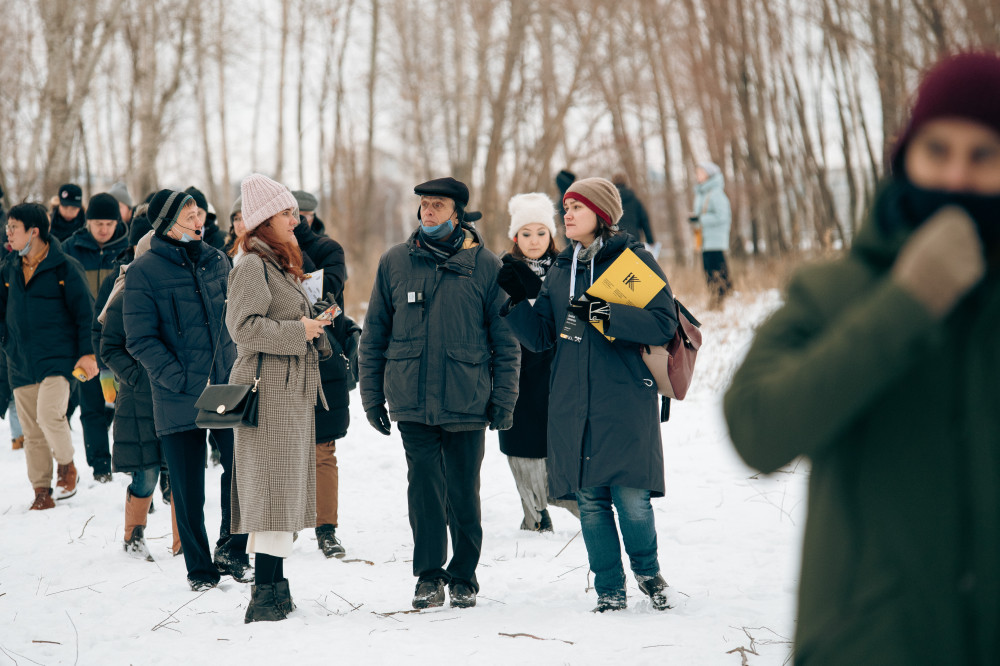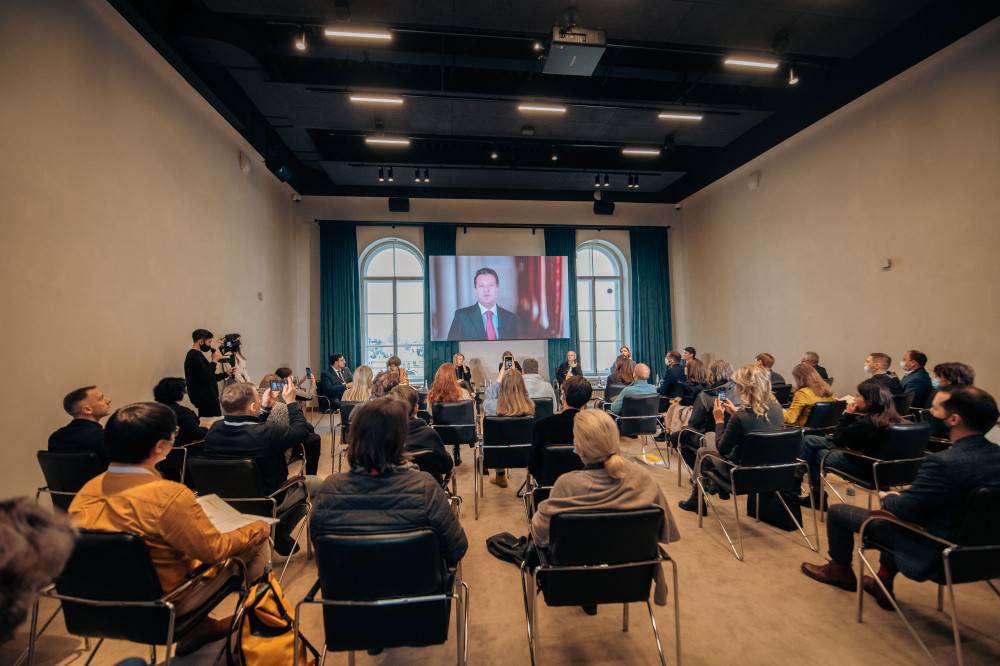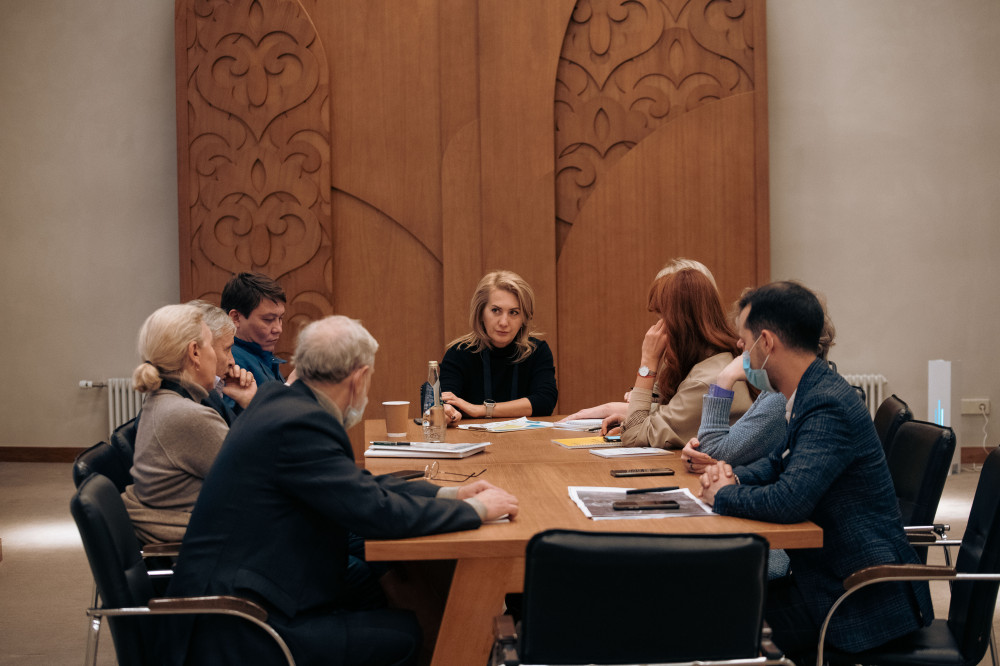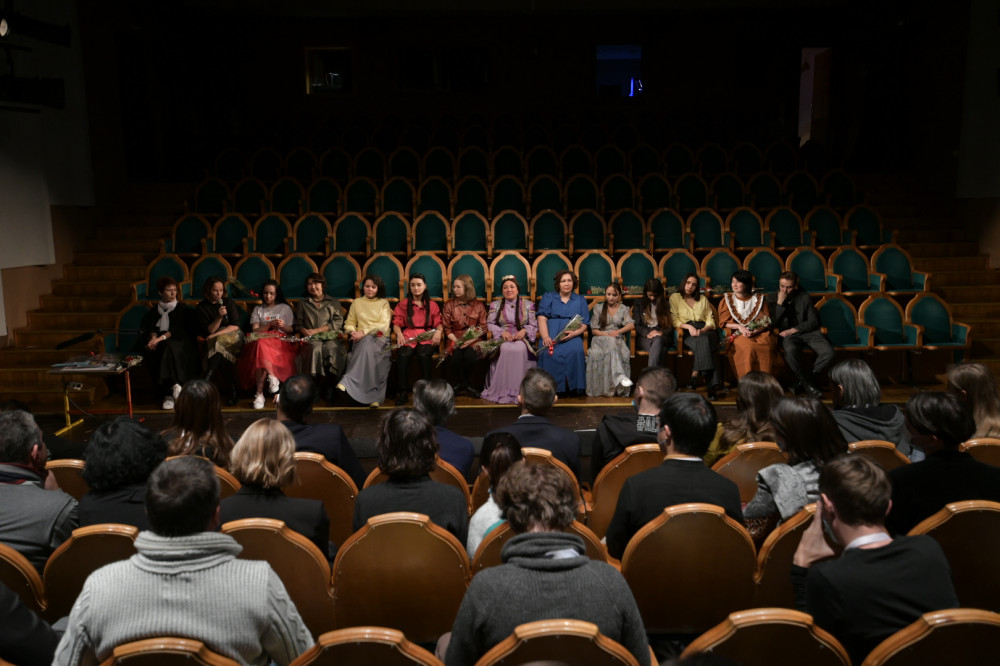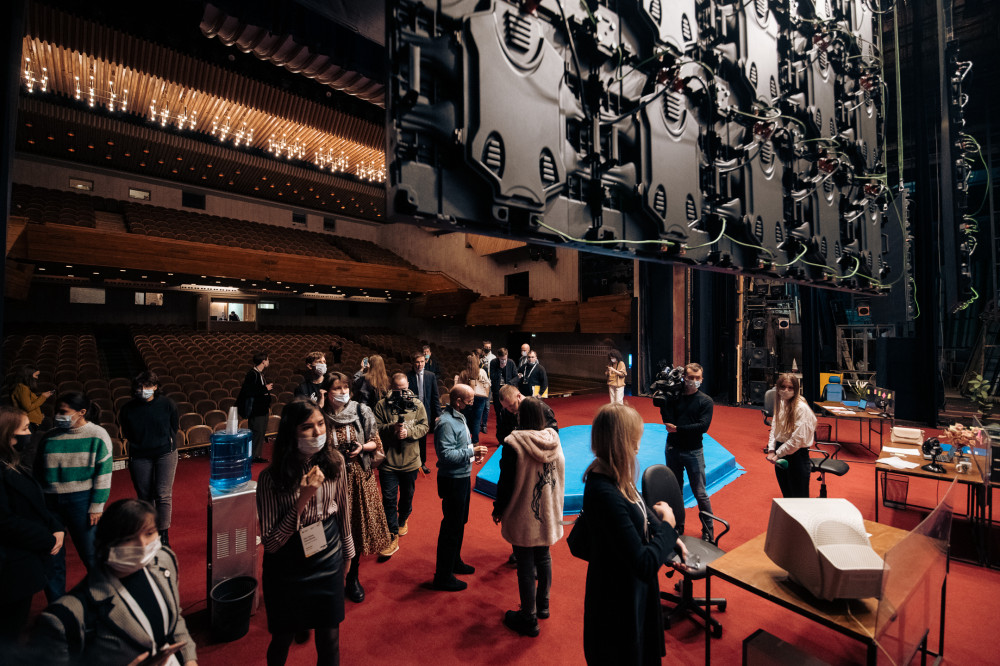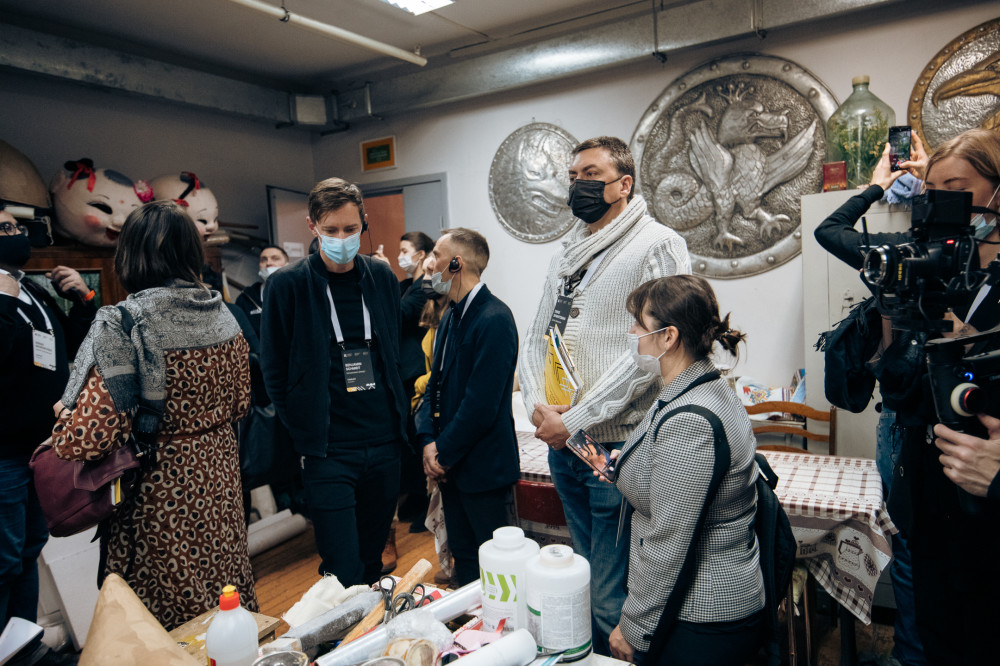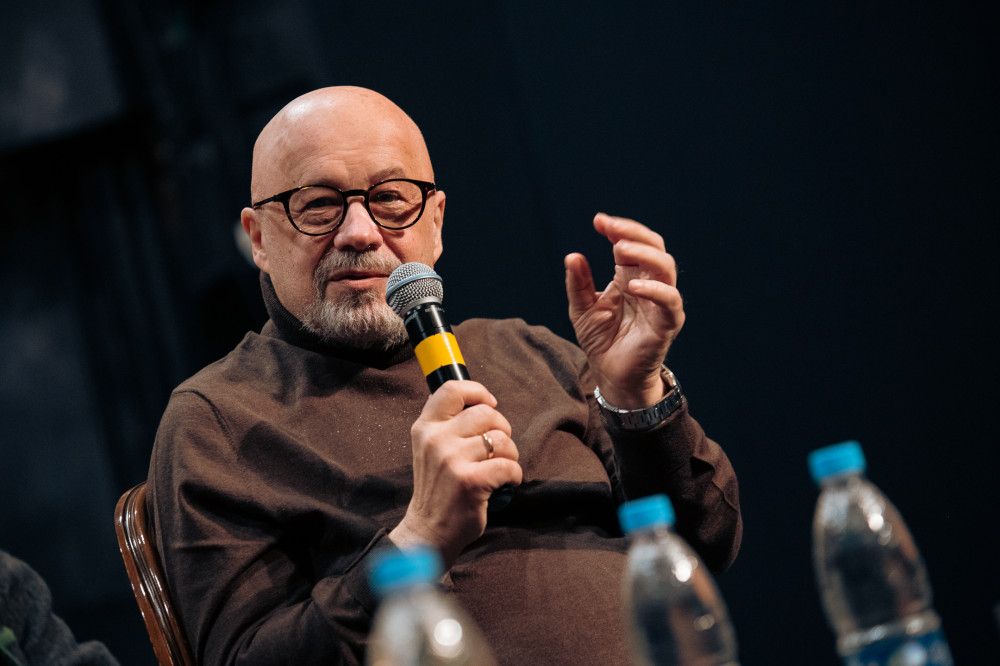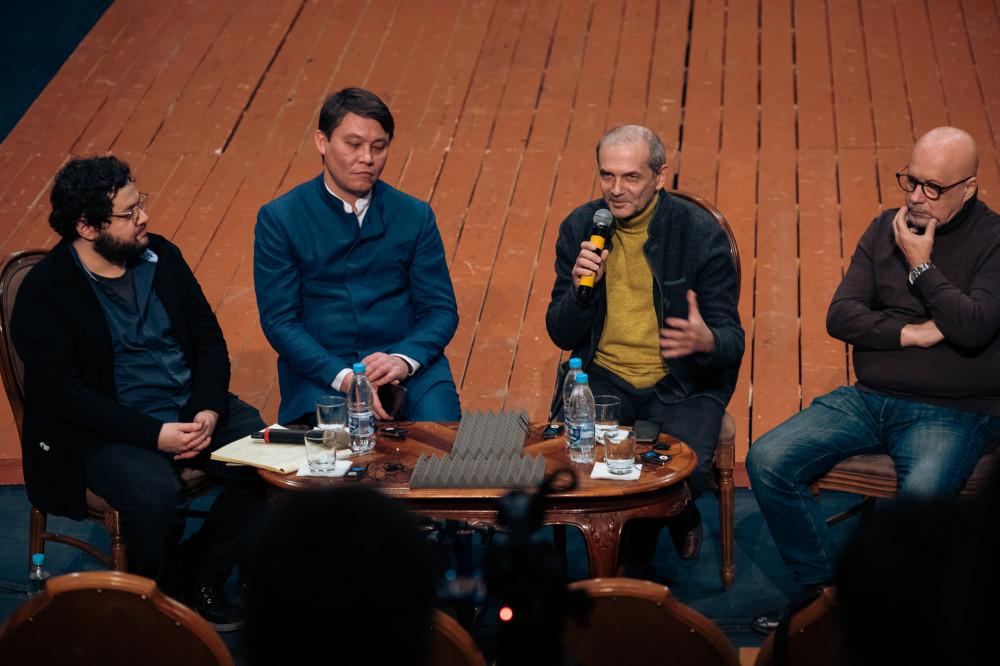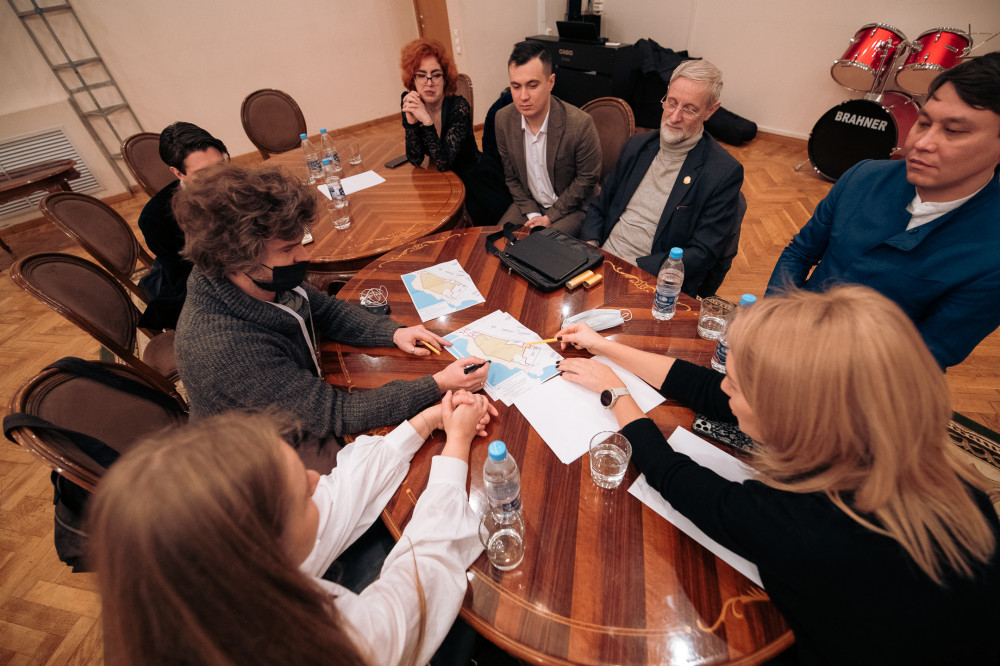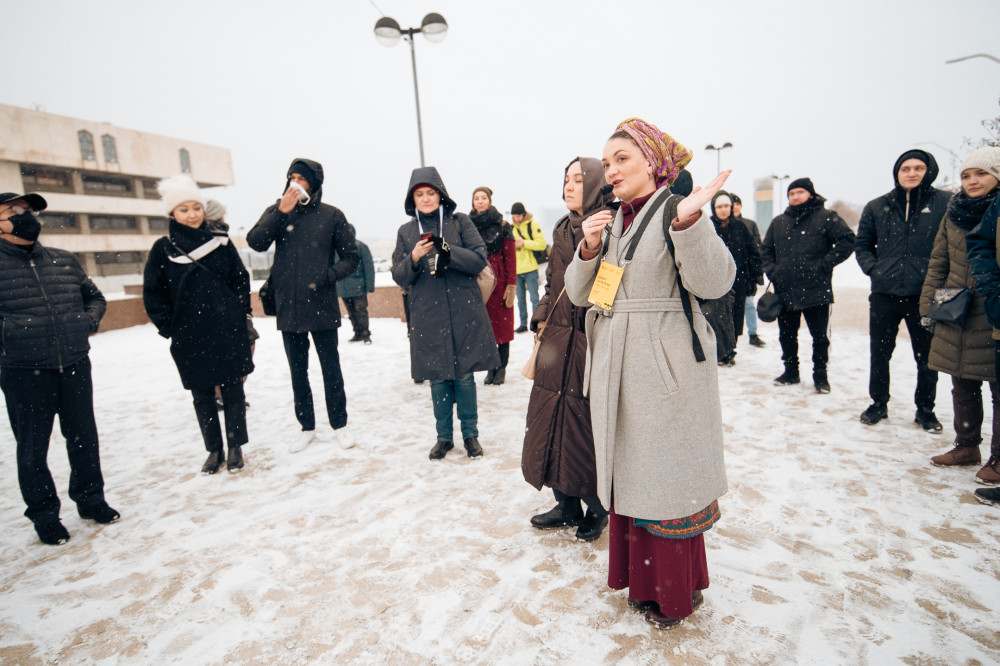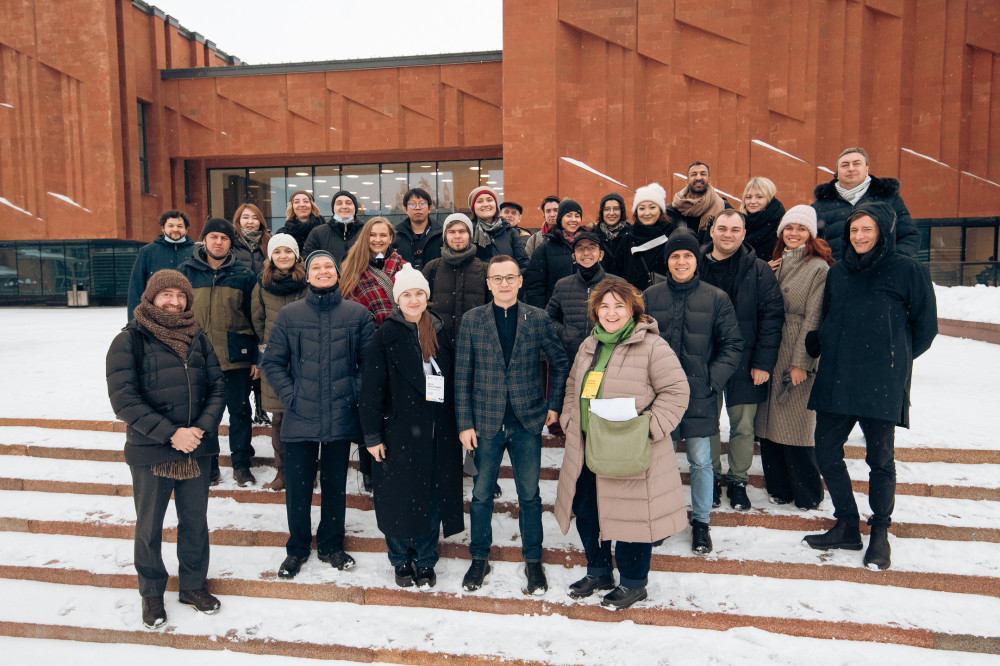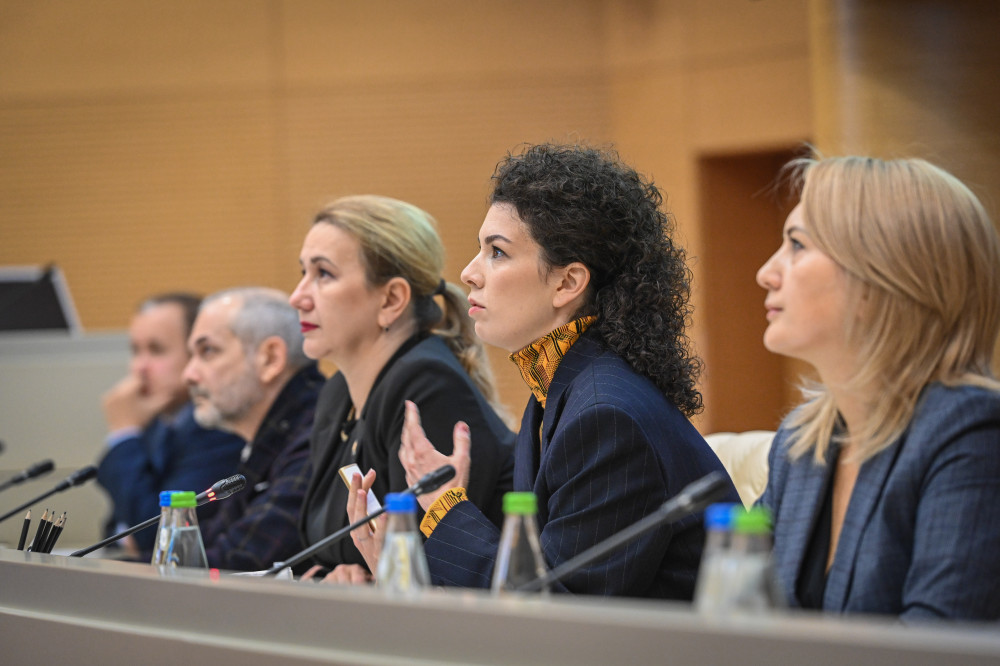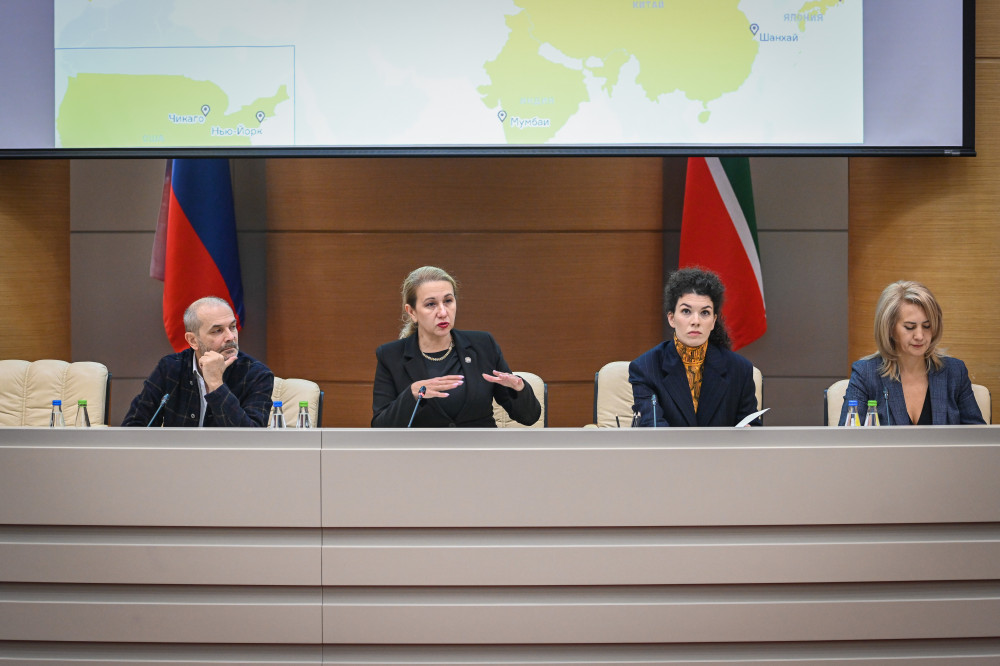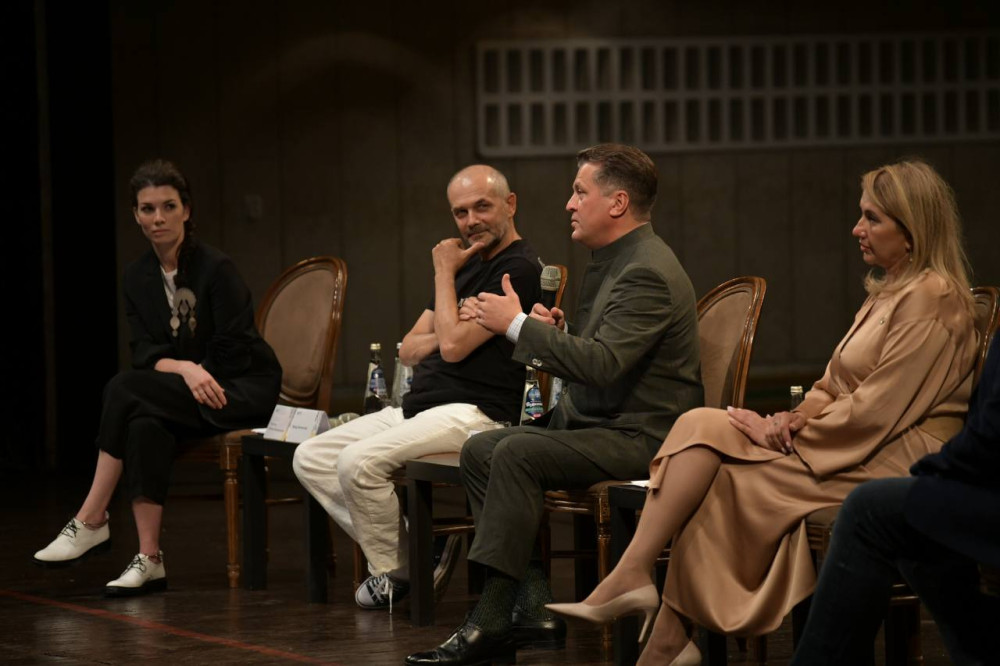Winner
-
1 Place
Consortium headed byConsortium membersKengo Kuma & Associates (Tokyo, Japan)Werner Sobek (Stuttgart, Germany)Brief description of the conceptThe shape of the new theater is inspired by “Ice Flowers,” a rare natural phenomenon that occurs on the surface of Kaban Lake. The building blends into the environment in winter, becoming part of the appearance of the lake. In summer, with multiple reflections from its transparent facades, the theater is unified with nature. Acuteness and earnestness are characteristic features of Tatar culture, architecture, and art.
The building is designed to be a part of the topography of the place, as a park with pedestrian routes and recreational areas, integrated and continuing the existing improvement of the embankments. A shape inspired by the soul of Tatarstan: Sharp and closed outside, but soft and warm inside. The building’s lighting is meant to bring warmth into the foyer and gradually dissolve it into the triangular panels of the facade. The bright decorative panels in the interior call back to traditional Tatar crafts and create a friendly atmosphere.
The foyer serves as the city’s “family room,” visually connecting the city and the lake. Entrances on all sides of the building continue pedestrian routes with natural light and ventilation. We create a comfortable environment and convenient routes for all theater workers — a spacious floor for artists and administration and comfortable workshops. We minimize the area of the basement floor to facilitate access and maintenance, as well as to reduce construction and operating costs.
-
2 Place
Consortium headed byConsortium membersAsif Khan Studio (London, UK)Charcoalblue (London, UK)AKTII (London, UK)Atelier Ten (Glasgow, UK)Brief description of the conceptThe look of the new facades is a reference to the complex, multi-layered cultural context of the Kamal Theatre. There are pieces of paper here — formerly handwritten texts of scripts for theatrical productions, now a perfect background to intensify the colors of nature. The silhouette of brick facades hides not only the image of the Kazan Kremlin and its white stone walls, but also the aesthetics of both Sufi philosophy and Soviet modernism, which strives for purity of form. Not a direct quote, but a call to discover.
The building does not suppress the existing landscape, but becomes a part of the shore of Nizhny Kaban Lake. All facades of the theater are equally important, as are the different worldviews, languages, cultural layers, and traditions within Tatar society. The only part that rises above the facades is the vertical cubic capacity of the stage box, representing a symbolic axis, the city's cultural life.
Panoramic glazing helps include the interior into urban views, making them even more eye-catching. The arched windows of the new theater resemble the silhouette of the old theater, which can be seen in the distance. So a strong connection between the past and the future can be felt. The large carved entrance door is another homage and reference to the ancient wooden architecture of the Tatar people.
-
3 Place
Consortium headed byConsortium membersCoop Himmelb(l)au (Vienna, Austria)Miriada Group (Kazan, Russia)Brief description of the conceptThe new Galiasgar Kamal Tatar State Academic Theatre embodies an open, consciously outwardly unstable architecture and thus reflects the idea of democracy. While the theater is aesthetically considered as a functional monument, the building itself is not a just a solid structure. It is, rather, an open space, receptive to both its surroundings and the possibilities around it.
The conceptual design of the new theater is dedicated to all visitors and to the citizens of Kazan. The new Kamal Theatre is not only a theater venue, but also a new public space that embodies architecture beyond its material incarnation. On the one hand, the theater exists in balance with the forces of nature, such as the sun, wind, water, and soil, while on the other hand, it is deeply rooted in local traditions and culture, thus becoming an ecologically oriented building and a place of cultural development.
The building and site, located between the city and the shore of Lake Kaban, can connect citizens with this natural landscape, becoming a new point of attraction. Infrastructural development and the creation of new connecting hubs will help develop the theater site, which will become a vibrant public space as well as a new tourist attraction for the city.
-
4 Place
Consortium headed byConsortium membersArchitect Bureau: FORM (Moscow, Russia)ZARF architects (Kazan, Russia)Brief description of the conceptshould be special. Its unique identity lies in the many cultural layers that can be seen in the new building.
The first of these layers is the landscape. The theater is located in a green area near Kaban Lake. The next layer is the ribbon of national ornaments, which reminds us of the blue shawl, the most famous production of the Kamal Theatre. In some places, the "shawl" is raised, forming entrances and the most spectacular visual connections between the interior and the park.
The experimental stage in the multipurpose hall corresponds to amethyst, which gives its owner inspiration and new ideas. The Great Hall is carnelian, a stone traditionally used as a central inlay in jewelry. In Islamic tradition, it’s believed that it protects family values. Finally, yellow chrysolite, as a symbol of leadership and wisdom, can be connected with the management block for the administration.
The facade of the administrative block plays a special role, forming the street front and embodying a theatrical curtain on the audience’s way to the theatrical action. The visitor crosses the open-fronted theater square, passes under the curtain into the archway, and enters the theater courtyard, sheltered from the street noise, with its street performances.
-
5 Place
Consortium headed byConsortium membersBorgos Pieper (Barcelona, Spain)Theatre Projects (Paris, France)Brief description of the conceptTheater Garden. The theater becomes a kind of replica of the famous Hanging Gardens of Generalife with its city balcony overlooking the lake. From above, the shape of the theater building resembles the outline of a leaf — a clear and memorable image for the audience. The shape and gracefulness of the theater facade facing Kaban Lake reminds one of the folds of a theater curtain or a wave of water. The simple Tatar architectural form is combined with decorative and ornate surfaces. Thus, the space of the main foyer, with three theater auditoriums looking like tea bowls with smooth surfaces, is covered with wood and brass like an unfinished picture.
The theater foyers are transformed into a town square, and the gardens become the theater grounds, with a variety of scenes and scenery inside the building and in the theater garden. The auditoriums face the lake, and the three-story Artisticheskaya Street creates interaction among visitors. A new festival plaza, Nauruz Square, appears just north of the new building. The project proposes the transformation of Khadi Taktash Street by making it predominantly pedestrian.
-
6 Place
Consortium headed byConsortium membersZaha Hadid Architects (London, UK)Atelier Ten (London, UK)Theatre Projects (London, UK)Brief description of the conceptThe concept is based on parametric forms with recognizable visual elements of Tatar cultural heritage.
Through the use of massive glass windows, the theater is visible from all sides. The foyer is filled with natural light, creating a smooth transition between the exterior and the interior. Five separated spaces make it possible to hold several events at the same time. In the center of the foyer, there is a restaurant with an open kitchen.
An elevated promenade is created around the theater, which gently descends to the water, and there are a berry meadow, assorted local grasses, and an amphitheater built into the landscape.
-
7 Place
Consortium headed byConsortium membersBURO SMART (Sait-Petersburg/Moscow, Russia)Brief description of the conceptThe new theater complex is part of an urban space with its own streets, squares, and parks. Two entrances on opposite sides of the theater are connected by a street, uniting two squares, northern and southern. Each of them has own mood and meaning: an active urbanized entrance from the south and a lyrical and contemplative one from the north. A simple order prevails in the architecture as a neutral frame, resistant to temporal changes and tolerant to any environment. The auditoriums are the unique objects, highlighted with special materials and national decorative elements.
Each of its spaces has a performative character and can be used for various plays, from the classical to the most unexpected. The theater is designed for 1,700 seats and has great options for leisure and educational functions. The physical space of the theater dissolves into the park, as almost all public areas have views of the city or the park.
The planning structure alludes to a traditional Tatar estate: buildings of different purposes are united by passageways and galleries, while small-scale rooms alternate with squares and gardens. The theater plays the role of a curtain or a portal between the city and the park, and between routine and dreams. It is a blank canvas for pure creation.
-
8 Place
Consortium headed byConsortium membersDA! Architects (Shanghai, China)Dialog urban planning (Kazan, Russia)Brief description of the conceptThe “Green Shawl” project offers a unique solution that unites a large park and the theater with fronts of Khadi Taktash and Nazarbayeva Streets. Thus, locals get their promised park on the Kaban Lake Embankment, loved by everyone, and an actively renewed Khadi Taktash Street, with an accent turnoff at the junction with Nazarbayeva Street.
The green hill does not destroy the panorama of Lake Kaban, but mimics the natural environment and reflects the natural landscape of Tatarstan with its grace and variety of vegetation A natural environment is created here, with water cascades, flowering trees and grasses, a murmuring brook, chirping birds, and buzzing insects. This is nature inspired by the entire rich culture of the Tatar people.
The current building of the Kamal Theatre has a strong architectural image, which for most citizens is inseparable from the theater itself. That is why we think it is impossible to propose a new expressive image: no architecturally striking proposal will be universally accepted by locals. A natural object will find an echo in the hearts of citizens and earn their respect, and that of visitors to the capital of Tatarstan.
-
Consortium members
Kengo Kuma & Associates (Tokyo, Japan)Werner Sobek (Stuttgart, Germany)Brief description of the concept
The shape of the new theater is inspired by “Ice Flowers,” a rare natural phenomenon that occurs on the surface of Kaban Lake. The building blends into the environment in winter, becoming part of the appearance of the lake. In summer, with multiple reflections from its transparent facades, the theater is unified with nature. Acuteness and earnestness are characteristic features of Tatar culture, architecture, and art.
The building is designed to be a part of the topography of the place, as a park with pedestrian routes and recreational areas, integrated and continuing the existing improvement of the embankments. A shape inspired by the soul of Tatarstan: Sharp and closed outside, but soft and warm inside. The building’s lighting is meant to bring warmth into the foyer and gradually dissolve it into the triangular panels of the facade. The bright decorative panels in the interior call back to traditional Tatar crafts and create a friendly atmosphere.
The foyer serves as the city’s “family room,” visually connecting the city and the lake. Entrances on all sides of the building continue pedestrian routes with natural light and ventilation. We create a comfortable environment and convenient routes for all theater workers — a spacious floor for artists and administration and comfortable workshops. We minimize the area of the basement floor to facilitate access and maintenance, as well as to reduce construction and operating costs.
-
Consortium members
Asif Khan Studio (London, UK)Charcoalblue (London, UK)AKTII (London, UK)Atelier Ten (Glasgow, UK)Brief description of the concept
The look of the new facades is a reference to the complex, multi-layered cultural context of the Kamal Theatre. There are pieces of paper here — formerly handwritten texts of scripts for theatrical productions, now a perfect background to intensify the colors of nature. The silhouette of brick facades hides not only the image of the Kazan Kremlin and its white stone walls, but also the aesthetics of both Sufi philosophy and Soviet modernism, which strives for purity of form. Not a direct quote, but a call to discover.
The building does not suppress the existing landscape, but becomes a part of the shore of Nizhny Kaban Lake. All facades of the theater are equally important, as are the different worldviews, languages, cultural layers, and traditions within Tatar society. The only part that rises above the facades is the vertical cubic capacity of the stage box, representing a symbolic axis, the city's cultural life.
Panoramic glazing helps include the interior into urban views, making them even more eye-catching. The arched windows of the new theater resemble the silhouette of the old theater, which can be seen in the distance. So a strong connection between the past and the future can be felt. The large carved entrance door is another homage and reference to the ancient wooden architecture of the Tatar people.
-
Consortium members
Coop Himmelb(l)au (Vienna, Austria)Miriada Group (Kazan, Russia)Brief description of the concept
The new Galiasgar Kamal Tatar State Academic Theatre embodies an open, consciously outwardly unstable architecture and thus reflects the idea of democracy. While the theater is aesthetically considered as a functional monument, the building itself is not a just a solid structure. It is, rather, an open space, receptive to both its surroundings and the possibilities around it.
The conceptual design of the new theater is dedicated to all visitors and to the citizens of Kazan. The new Kamal Theatre is not only a theater venue, but also a new public space that embodies architecture beyond its material incarnation. On the one hand, the theater exists in balance with the forces of nature, such as the sun, wind, water, and soil, while on the other hand, it is deeply rooted in local traditions and culture, thus becoming an ecologically oriented building and a place of cultural development.
The building and site, located between the city and the shore of Lake Kaban, can connect citizens with this natural landscape, becoming a new point of attraction. Infrastructural development and the creation of new connecting hubs will help develop the theater site, which will become a vibrant public space as well as a new tourist attraction for the city.
-
Consortium members
Architect Bureau: FORM (Moscow, Russia)ZARF architects (Kazan, Russia)Brief description of the concept
should be special. Its unique identity lies in the many cultural layers that can be seen in the new building.
The first of these layers is the landscape. The theater is located in a green area near Kaban Lake. The next layer is the ribbon of national ornaments, which reminds us of the blue shawl, the most famous production of the Kamal Theatre. In some places, the "shawl" is raised, forming entrances and the most spectacular visual connections between the interior and the park.
The experimental stage in the multipurpose hall corresponds to amethyst, which gives its owner inspiration and new ideas. The Great Hall is carnelian, a stone traditionally used as a central inlay in jewelry. In Islamic tradition, it’s believed that it protects family values. Finally, yellow chrysolite, as a symbol of leadership and wisdom, can be connected with the management block for the administration.
The facade of the administrative block plays a special role, forming the street front and embodying a theatrical curtain on the audience’s way to the theatrical action. The visitor crosses the open-fronted theater square, passes under the curtain into the archway, and enters the theater courtyard, sheltered from the street noise, with its street performances.
-
Consortium members
Borgos Pieper (Barcelona, Spain)Theatre Projects (Paris, France)Brief description of the concept
Theater Garden. The theater becomes a kind of replica of the famous Hanging Gardens of Generalife with its city balcony overlooking the lake. From above, the shape of the theater building resembles the outline of a leaf — a clear and memorable image for the audience. The shape and gracefulness of the theater facade facing Kaban Lake reminds one of the folds of a theater curtain or a wave of water. The simple Tatar architectural form is combined with decorative and ornate surfaces. Thus, the space of the main foyer, with three theater auditoriums looking like tea bowls with smooth surfaces, is covered with wood and brass like an unfinished picture.
The theater foyers are transformed into a town square, and the gardens become the theater grounds, with a variety of scenes and scenery inside the building and in the theater garden. The auditoriums face the lake, and the three-story Artisticheskaya Street creates interaction among visitors. A new festival plaza, Nauruz Square, appears just north of the new building. The project proposes the transformation of Khadi Taktash Street by making it predominantly pedestrian.
-
Consortium members
Zaha Hadid Architects (London, UK)Atelier Ten (London, UK)Theatre Projects (London, UK)Brief description of the concept
The concept is based on parametric forms with recognizable visual elements of Tatar cultural heritage.
Through the use of massive glass windows, the theater is visible from all sides. The foyer is filled with natural light, creating a smooth transition between the exterior and the interior. Five separated spaces make it possible to hold several events at the same time. In the center of the foyer, there is a restaurant with an open kitchen.
An elevated promenade is created around the theater, which gently descends to the water, and there are a berry meadow, assorted local grasses, and an amphitheater built into the landscape.
-
Consortium members
BURO SMART (Sait-Petersburg/Moscow, Russia)Brief description of the concept
The new theater complex is part of an urban space with its own streets, squares, and parks. Two entrances on opposite sides of the theater are connected by a street, uniting two squares, northern and southern. Each of them has own mood and meaning: an active urbanized entrance from the south and a lyrical and contemplative one from the north. A simple order prevails in the architecture as a neutral frame, resistant to temporal changes and tolerant to any environment. The auditoriums are the unique objects, highlighted with special materials and national decorative elements.
Each of its spaces has a performative character and can be used for various plays, from the classical to the most unexpected. The theater is designed for 1,700 seats and has great options for leisure and educational functions. The physical space of the theater dissolves into the park, as almost all public areas have views of the city or the park.
The planning structure alludes to a traditional Tatar estate: buildings of different purposes are united by passageways and galleries, while small-scale rooms alternate with squares and gardens. The theater plays the role of a curtain or a portal between the city and the park, and between routine and dreams. It is a blank canvas for pure creation.
-
Consortium members
DA! Architects (Shanghai, China)Dialog urban planning (Kazan, Russia)Brief description of the concept
The “Green Shawl” project offers a unique solution that unites a large park and the theater with fronts of Khadi Taktash and Nazarbayeva Streets. Thus, locals get their promised park on the Kaban Lake Embankment, loved by everyone, and an actively renewed Khadi Taktash Street, with an accent turnoff at the junction with Nazarbayeva Street.
The green hill does not destroy the panorama of Lake Kaban, but mimics the natural environment and reflects the natural landscape of Tatarstan with its grace and variety of vegetation A natural environment is created here, with water cascades, flowering trees and grasses, a murmuring brook, chirping birds, and buzzing insects. This is nature inspired by the entire rich culture of the Tatar people.
The current building of the Kamal Theatre has a strong architectural image, which for most citizens is inseparable from the theater itself. That is why we think it is impossible to propose a new expressive image: no architecturally striking proposal will be universally accepted by locals. A natural object will find an echo in the hearts of citizens and earn their respect, and that of visitors to the capital of Tatarstan.
COMPETITION
-
AIM
Development of an architectural concept for Galiasgar Kamal Tatarian State Academy Theatre.
-
OBJECTIVES
1. Priority in preserving and developing Tatar national culture and language;2. Preservation of unique national features in the architectural appearance and design of the building;3. Creating a modern cultural space essential to residents of and visitors to Kazan and all potential Tatar viewers living in different parts of Russia and the world;4. Development of new formats of public work – enlightening formats (lectures, discussions, film screenings) and educational (clubs, schools, laboratories) to attract new audiences;5. Incorporating the theatre into the ecosystem of Lake Kaban;6. Increasing the efficiency of work and improving working conditions for the theatre staff, taking into account scenarios of individual visits by all categories of users. -
JURY
The winner will be the creator of the best proposal as chosen by a vote of the competition jury. Based on the results of the meeting of the Jury, the winner and two finalists will receive additional payments corresponding to their positions.
-
DESIGN PRINCIPLES
- Respect
Respect for all futures users, both audience members and theatre employees, must be considered in the design.
- Future orientation
Spaces should provide resources for the Kamal Theatre development and not limit its future.
- Independence and inclusion
Spaces should allow for independence and autonomy among the visitors, without the need for expertise. This also means the inclusivity of spaces, taking into account the interests of groups with limited mobility, those who are hearing or visually impaired, and other special audiences.
- Continuity
It is necessary to ensure the continuity of the Kamal Theatre's traditions: enable attractive representation of its history and contemporary activities in future spaces.
- Urban inclusion
Kamal Theatre is part of the urban environment. New spaces should help the theatre fit into the new life of Lake Kaban, taking into account the historical and urban planning context.
- Respect
-
FINALISTS
As a result of the first stage, seven finalists will be selected on the basis of a relevant portfolio and essays where they develop their proposals.
-
PRIZE FUND
The winner will be the creator of the best proposal as chosen by a vote of the competition jury. Based on the results of the meeting of the Jury, the winner and two finalists will receive additional payment equal to following sums:
-
Prize for the winner – 2,500,000 rubles,
including all taxes and fees. -
Prize for 2nd place – 1,500,000 rubles,
including all taxes and fees. -
Prize for 3rd place – 1,000,000 rubles,
including all taxes and fees.
-
SCHEDULE
-
23 July
Start of the competition, press conference
202123 July
Start of the competition, press conference
-
22 September
Deadline for applications
202122 September
Deadline for applications
-
7 October
Expert Council meeting
20217 October
Expert Council meeting
-
12 October
Jury meeting
202112 October
Jury meeting
-
27 - 28 November
Installation seminar for finalists
202127 - 28 November
Installation seminar for finalists
-
3 February
End of acceptance of competitive proposals
20223 February
End of acceptance of competitive proposals
-
15 February
Expert Council meeting
202215 February
Expert Council meeting
-
16 February
Jury meeting for selection of the winner
202216 February
Jury meeting for selection of the winner
-
17 February
Press conference. Announcement of the Winner
202217 February
Press conference. Announcement of the Winner
COMPETITION TERRITORY
-
2,04 ha
Total area of the competition
territory -
56 ha
Lake territory
Nizhny Kaban -
1906 year
Date of birth of the
Tatar theater -
1939 year
The theater was named after a classic
of Tatar drama - Galiasgara Kamala
COMPETITION JURY
-

Ilsur Metshin
Mayor of Kazan -

Farrokh Derakhshani
Director of the Aga Khan Award -

Farid Bikchantayev
Chief director of the Tatar State Academic Theater. Galiasgara Kamala -

Gokhan Avcioglu
Founder of GAD Architecture, the member of RIBA, founder of the Foundation for the Development of Innovative Architecture «GAD Foundation» -

David Basulto
Founder, chief editor of Archdaily.com -

Attila Vidnyánszky
Artistic Director of the Hungarian National Theater, Budapest -

Marat Aizatullin
Minister of Construction, Architecture and Housing and Communal Services of the Republic of Tatarstan -

Irada Ayupova
Minister of Culture of the Republic of Tatarstan -

Rimma Bikmukhametova
Tatar journalist, public figure -

Razil Valeev
People's poet of the Republic of Tatarstan -

Nikolay Vasiliev
Member of the Board of the Union of Architects of the Republic of Tatarstan, Advisor to the Minister of Construction, Architecture and Housing and Communal Services of the Republic of Tatarstan -

Iskander Gilyazov
Director of the separate structural subdivision "Institute of the Tatar Encyclopedia and Regional Studies of the Academy of Sciences of the Republic of Tatarstan" -

Yuri Grigoryan
Head of the architectural bureau «Project Meganom» -

Nikolay Kikava
Deputy Director for Scientific Work of the GAU «Scientific Research and Design Institute of Urban Planning of the City of Moscow» -

Totan Kuzembaev
Head of the «Architectural Workshop of Totan Kuzembaev» -

Sergey Kuznetsov
First Deputy Chairman of the Committee for Architecture and Urban Planning of the city of Moscow -

Mikhail Mikadze
Founding partner of the architectural bureau ХОРА, teacher of the diploma studio MARСH -

Evgeny Mironov
Artistic Director of the State Theater of Nations -

Maria Privalova
General Director of the Moscow State Budgetary Institution of Culture «Central Library named after N.A. Nekrasov» -

Tatiana Prokofieva
Advisor to the Mayor of Kazan for Architecture and Urban Planning -

Radik Salikhov
Doctor of Historical Sciences, Director of the Institute of History named after Sh.Marjani -

Alexandr Sladkovsky
Russian conductor. Artistic Director and Chief Conductor of the State Symphony Orchestra of the Republic of Tatarstan -

Rustam Suleimanov
Founder of Mardjani Foundation -

Rinat Tazetdinov
People's Artist of the Republic of Tatarstan and the Russian Federation, artist of the Kamal Theater -

Ilsiyar Tukhvatullina
Chief Architect of Kazan -

Ilfat Fayzrakhmanov
Editor-in-Chief of the Beznen newspaper -

Valery Fokin
Artistic Director of the Federal State Budgetary Institution "National Drama Theater of Russia (Alexandrinsky Theater)" -

Iskander Khairullin
People's Artist of the Republic of Tatarstan, artist of the Kamal Theater -

Chulpan Khamatova
Theater and film actress, public figure, People's Artist of Russia -

Adel Khusnutdinov
General Director of State Unitary Enterprise Tatinvestgrazhdanproekt -

Oyat Shukurov
Partner of the architectural bureau ХОРА, teacher of the diploma studio MARCH -

Boris Yukhananov
Artistic Director of the Stanislavsky Electrotheatre -

Tabris Yarullin
Deputy Director of the National Library of the Republic of Tatarstan
Experts
-

Natalia Fishman-Bekmambetova
Adviser to the President of the Republic of Tatarstan -

Ilfir Yakupov
Director of the Tatar State Academic Theater named after G. Kamala, Co-Chair of the Expert Council -

Marat Zakirov
Head of the Administration of the Vakhitovsky and Privolzhsky districts of the city of Kazan -

Guzel Sagitova
Deputy Head of the Executive Committee of Kazan for Social Issues -

Dilbar Sadykova
Member of the Commission on Culture of the Public Chamber of the Republic of Tatarstan, General Director of ANO «Center for Tourism Development of the Republic of Tatarstan» -

Vladimir Kudryashev
Deputy Minister of Construction, Architecture and Housing and Communal Services of the Republic of Tatarstan -

Niyaz Iglamov
Theater critic, curator of special projects of the Tatar State Academic Theater named after G. Kamala -

Ilnaz Khaybullin
Head of the art and production department of the Tatar State Academic Theater named after G. Kamala -

Radik Bariev
Actor of the Tatar State Academic Theater named after G. Kamal, People's Artist of Tatarstan, laureate of the State Prize of the Republic of Tatarstan named after Tukaya -

Alfrid Bustanov
Deputy Director of the Institute of History named after Marjani -

Rkail Zaydullin
Poet, writer, Head of the Writers' Union of the Republic of Tatarstan, laureate of the State Prize of the Republic of Tatarstan named after G. Tukai -

Ilgiz Zainiev
Artistic director of the Ekiyat puppet theater -

Rail Sadriev
Artistic Director, Director of the Buinsky State Drama Theater -

Yuri Alshits
Artistic Director of the World Theater Training Institute - ITI UNESCO -

Radif Kashapov
Journalist of the site «Realnoe Vremya» -

Airat Faizrakhmanov
Candidate of Historical Sciences, Deputy Chairman of the World Forum of Tatar Youth -

Anton Flerov
Curator of the Theater Institute -

Inna Yarkova
Co-founder and Director of the Living City Foundation for the Support of Contemporary Art -

Salima Aminova
Honored Art Worker of the Republic of Tatarstan, choreographer of the Kamal Theatre -

Mikhail Bychkov
Theater Director, Founder and Artistic Director of the Voronezh Chamber Theater, Honored Art Worker of the Voronezh Region -

Sergey Skomorokhov
Chief artist of the Tatar State Academic Theater named after G. Kamal -

Aigul Davletshina
Art manager, specialist in socio-cultural programming, co-founder of the multidisciplinary production company creeptone.media -

Svetlana Persova
Associate Professor of the Department of Reconstruction, Restoration of Architectural Heritage and Fundamentals of Architecture -

Alexander Ostrogorsky
Teacher of the MARCH architecture school -

Andrey Borisov
Sakha Academic Theater named after P.A. Oyunsky -

Suhrob Shekhov
Chief Director of the State Theater of Musical Comedy named after K. Khujandi -

Sharshebek Sheishenov
Director and Artistic Director of the State Youth Theater «Uchur» -

Ayrat Abushakhmanov
Chief director of the Bashkir Academic Drama Theater named after M. Gafuri -

Azat Abzalov
Head of the Department of Culture of the Executive Committee of Kazan -

Israfil Ramazan oglu Israfilov
Azerbaijan State University of Culture and Arts -

Valery Yakovlev
Artistic Director of the Chuvash State Academic Drama Theater named after K.V. Ivanova -

Marya Leontieva
Founder of the Institute of Urban Studies «Tamga» -

Enzhe Dusaeva
Founder of the Institute of Urban Studies «Tamga» -

Sergey Sanachin
Architect-urban planner, author of books on the architecture of Kazan, member of the Union of Architects of Russia -

Guzel Suleimanova-Valeeva
Doctor of Arts, Professor, Honored Scientist of the Republic of Tatarstan -

Raif Nizametdin
Investment manager -

Renat Tumarov
Head of the art and production department of the Alexandrinsky Theater -

Maria Ignatieva
Head of the Department of Scientific, Methodological and Research Work of the «Central Library named after N.A. Nekrasov» -

The Theater of the Townspeople
News
All news-
17 February 2022
 The winner of the competition is determined
The winner of the competition is determined -
16 February 2022
 FEBRUARY 17 AT 11:00 THE WINNER WILL BE ANNOUNCED
FEBRUARY 17 AT 11:00 THE WINNER WILL BE ANNOUNCED -
16 February 2022
 THE JURY’S MEETING TOOK PLACE TODAY
THE JURY’S MEETING TOOK PLACE TODAY -
16 February 2022
 RUSTAM MINNIKHANOV FAMILIARIZED HIMSELF WITH COMPETITION FINALISTS’ PROJECTS
RUSTAM MINNIKHANOV FAMILIARIZED HIMSELF WITH COMPETITION FINALISTS’ PROJECTS -
15 February 2022
 Final meeting of the Jury to take place on February 16
Final meeting of the Jury to take place on February 16 -
15 February 2022
 AN EXPERT COUNCIL MEETING TOOK PLACE
AN EXPERT COUNCIL MEETING TOOK PLACE -
14 February 2022
 Meeting of the Expert Council to take place on February 15
Meeting of the Expert Council to take place on February 15 -
03 February 2022
 Finalists complete their work on projects
Finalists complete their work on projects -
14 January 2022
 Presentations of results of work by Finalists of the Competition
Presentations of results of work by Finalists of the Competition -
29 December 2021
 THE FINALISTS OF THE COMPETITION FOR THE ARCHITECTURAL CONCEPT FOR KAMAL THEATRE VISIT KAZAN
THE FINALISTS OF THE COMPETITION FOR THE ARCHITECTURAL CONCEPT FOR KAMAL THEATRE VISIT KAZAN -
28 November 2021
 The second day of the Orientation Seminar has come to a close
The second day of the Orientation Seminar has come to a close -
27 November 2021
 Participants of the Theater of the townspeople entered the Expert Council of the Competition
Participants of the Theater of the townspeople entered the Expert Council of the Competition -
27 November 2021
 The first day of the Orientation Seminar: review
The first day of the Orientation Seminar: review -
23 November 2021
 CONSORTIA REPRESENTATIVES GO TO KAZAN!
CONSORTIA REPRESENTATIVES GO TO KAZAN! -
02 November 2021
 An orientation webinar was held with competition finalists on the topic “Territory Context. Priorities and Limitations”
An orientation webinar was held with competition finalists on the topic “Territory Context. Priorities and Limitations” -
26 October 2021
 The Orientation Webinar with the competition Finalists took place online on October 26
The Orientation Webinar with the competition Finalists took place online on October 26 -
19 October 2021
 A briefing took place dedicated to the competition for development of an architectural concept of Galiasgar Kamal Theatre
A briefing took place dedicated to the competition for development of an architectural concept of Galiasgar Kamal Theatre -
12 October 2021
 8 FINALISTS HAVE BEEN SELECTED FOR DEVELOPMENT OF A CONCEPT FOR THE NEW KAMAL THEATRE BUILDING
8 FINALISTS HAVE BEEN SELECTED FOR DEVELOPMENT OF A CONCEPT FOR THE NEW KAMAL THEATRE BUILDING -
22 September 2021
 ACCEPTANCE OF APPLICATIONS FOR THE INTERNATIONAL COMPETITION TO DEVELOP AN ARCHITECTURAL CONCEPT OF THE GALIASGAR KAMAL THEATRE HAS ENDED
ACCEPTANCE OF APPLICATIONS FOR THE INTERNATIONAL COMPETITION TO DEVELOP AN ARCHITECTURAL CONCEPT OF THE GALIASGAR KAMAL THEATRE HAS ENDED -
14 September 2021
 CALL FOR APPLICATIONS FOR THE INTERNATIONAL COMPETITION TO DEVELOP A CONCEPT FOR THE TATAR KAMALA THEATRE EXTENDED TO SEPTEMBER 22
CALL FOR APPLICATIONS FOR THE INTERNATIONAL COMPETITION TO DEVELOP A CONCEPT FOR THE TATAR KAMALA THEATRE EXTENDED TO SEPTEMBER 22 -
23 July 2021
 Launch of the international competition for development of an architectural concept of Galiasgar Kamal Theatre
Launch of the international competition for development of an architectural concept of Galiasgar Kamal Theatre
Articles
ALL PUBLICATIONS-
Source ArchdailyThe Galiasgar Kamal Tatar State Academy Theatre Competition Announces Finalists
-
Source Competitions.ArchiArchitectural concept for Kamal Theatre
-
Source E-architectGaliasgar Kamal Theatre Design Competition
-
Source WorldarchitectureCompetition Launched For Development Of Architectural Concept Of Galiasgar Kamal Theatre In Russia
-
Source WorldarchitectureCompetition Launched For Development Of Architectural Concept Of Galiasgar Kamal Theatre In Russia
-
Source Kzn.ruAn international competition for the development of the concept of a new building of the G. Kamal theater in Kazan





































